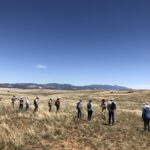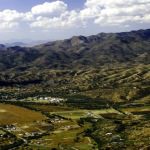Save the Scenic Santa Ritas PRESS RELEASE
June 23, 2014

HudBay’s acquisition changes nothing – Rosemont is still a bad project
(TUCSON, Ariz.) Today’s announcement that Augusta Resource Corporation has accepted Toronto-based Hudbay Minerals’ hostile takeover bid does nothing to change the simple facts that the proposed massive Rosemont open pit copper mine in the Santa Rita Mountains south of Tucson would inflict devastating impacts on southern Arizona’s environment and economy and still faces daunting regulatory challenges.
“The proposed Rosemont Mine will always be a bad project no matter who owns it,” said SSSR president Gayle Hartmann. “The massive open pit mine threatens southern Arizona’s drinking water, air quality, wildlife and mountains. We will continue to oppose this terrible proposal until it is defeated.”
The U.S. Environmental Protection Agency has stated that the massive open-pit mine that would destroy more than 3,000 acres of Coronado National Forest would result in ‘substantial and unacceptable impact’ to water supplies of ‘national importance’ and that proposed mitigation measures are ‘scientifically flawed’ and ‘grossly inadequate.’
Today’s news that Augusta accepted the bid also exposes the company’s repeated promises that it was “committed” to the region as nothing more than a deceptive public relations campaign trying to convince southern Arizonans that the Rosemont Mine was somehow essential to the future of southern Arizona’s economy. “
Nothing could be further from the truth,” said Dr. Tom Purdon, a Green Valley physician and SSSR board member. “And the truth is something both Augusta and its Rosemont Copper subsidiary have been playing fast and loose with since Day One. There are some places that mines don’t belong because the harm that would be caused outweighs any potential benefits, and the Santa Rita Mountains are one of those places. The proposed Rosemont Mine will inflict irreparable damage that will destroy one of the most important watersheds in Arizona and threaten the health of area residents until long after the mine is closed.
HudBay now assumes the regulatory burden of getting the project approved which, given recent developments, is far from certain. Major regulatory hurdles remain, including:
The Final Environmental Impact Statement (FEIS) is inadequate and may have to be revised or supplemented. Not only does the FEIS for the proposed mine present significant new information that must be put out for another round of public comment but it is missing information on impacts of the mine to private well owners, impacts of displaced recreation, invasive species, impacts to migratory birds from the toxic pit lake, revegetation, and many more potential economic and environmental effects. In addition, its identification and analysis of the effectiveness of proposed mitigation measures is seriously flawed. While the Forest Service has rejected a number of specific objections filed by Arizona citizens and local governments, earlier this month the Regional Forester directed the Coronado National Forest Supervisor to consider either revising or supplementing the FEIS in light of new information and following the completion of a new round of consultation under the Endangered Species Act.
Rosemont air pollution permit challenged in court. A lawsuit has been filed in Maricopa County (AZ) Superior Court seeking to overturn the state’s illegal decision to issue an air pollution permit for the Rosemont mine. The suit alleges that the modeling information Rosemont provided the state was based on data that was manipulated in a misleading attempt to show that the mine operations would comply with air quality standards.
The Fish and Wildlife Service and Forest Service reinitiate Endangered Species Act consultations. The recent photograph of an ocelot near the proposed Rosemont copper mine site, combined with new information on the impacts to water supplies on which other endangered species depend, has triggered a new round of formal Endangered Species Act consultations between the two federal agencies. New information about the proposed mine’s potential depletion of water resources on the federally-owned Las Cienegas National Conservation Area located in the valley immediately east of the Santa Rita Mountains indicate that the project impacts on water-based endangered species is much more serious than previously anticipated.
The US Army Corps of Engineers deems the plan to mitigate the Rosemont Mine’s damage to vital watershed inadequate, thus jeopardizing the essential Sec. 404 permit. The Army Corps notified Rosemont last month that its most recent mitigation plan in its application for a Clean Water Act permit fails to fully compensate for damage the proposed mine would cause to springs, washes and wetlands. The mine cannot be built without the 404 permit.
The U.S. Environmental Protection Agency (EPA) recommended denial of the Rosemont Sec. 404 Clean Water Act permit. In a November letter sent to the Army Corps, the EPA states that the proposed wetlands mitigation plan to compensate for the loss of jurisdictional waters of the United States is “insufficient to avoid ‘significant degradation’ of the aquatic ecosystem.” The EPA stated “the proposed mitigation is grossly inadequate to compensate for the mine’s impact.”
It is important to note that ultimately EPA has veto authority over this permit.
Federal, State, and County jurisdictions object to water quality certification for the Rosemont project. Pima County, the EPA, the Army Corps and the Arizona Department of Game and Fish have all raised serious concerns regarding a critical state water quality protection certification that is needed before construction can begin. The state certification must be issued before the Army Corps can approve the 404 permit and construction can begin on the mine.
The proposed Rosemont Mine will significantly impact the water resources of a congressionally-established National Conservation Area. The BLM-managed Las Cienegas National Conservation Area lies in the valley directly east of Rosemont’s proposed mile-wide, half-mile deep open-pit copper mine. The 45,000-acre conservation area was protected by Congress in part to protect the northerly-flowing Cienega Creek that bisects the site. The Final Environmental Impact Statement states the mine is likely to have negative impacts on Cienega Creek by lowering the groundwater table and reducing the surface flows on important tributaries, including Empire Gulch and Davidson Canyon. Two streams flowing from the Santa Rita Mountains into the conservation area are listed as Outstanding Arizona Waters and are legally protected from any degradation.
Key state groundwater pollution permit taken to court. SSSR filed a lawsuit challenging the issuance of the Aquifer Protection Permit (APP), a key state water permit needed to begin construction of the mine. The project would be constructed in a watershed that provides recharge to a primary drinking water aquifer for a community of almost 1 million. The suit alleges, among other things, that the state illegally issued the permit without taking into account the mine’s impact on surface waters. A decision is expected later this summer.
The proposed mine’s devastating impacts to the land and water has generated widespread and determined opposition to the project. Opponents include:
Native American Communities — The Tohono O’odham Nation and Pascua Yaqui Tribe, the tribal governments in the vicinity of the proposed mine, stated in a jointly authored column published in the local paper, that “this mine will destroy our sacred lands known as Ce:wi Duag by the Tohono O’odham and Heweli Sewa Kawi by the Pascua Yaqui that link our ancestors to our future generations.”
Local governments — The City of Tucson, Pima County, Santa Cruz County, Town of Patagonia, and Green Valley Community Coordinating Council have all passed resolutions against the project. Opposition remains steadfast in spite of Rosemont’s failed attempts to influence local elections by backing candidates seeking to defeat elected officials and candidates that oppose the mine.
National and Arizona conservation organizations — In January, a dozen Arizona and national environmental groups sent a joint letter to elected officials requesting that they oppose the construction of the proposed mine. The “short-sighted mining proposal, [is] a project that would primarily enrich a handful of foreign investors at the expense of those of us whose lives and livelihoods would be jeopardized by the mine’s depletion of precious groundwater supplies and its pervasive round-the-clock water, air, noise, and light pollution,” the letter stated.
Save the Scenic Santa Ritas is a non-profit, community organization working to protect the Santa Rita and Patagonia Mountains from environmental degradation caused by mining and mineral exploration activities. For more information, go to ScenicSantaRitas.org or RosemontMineTruth.com.











